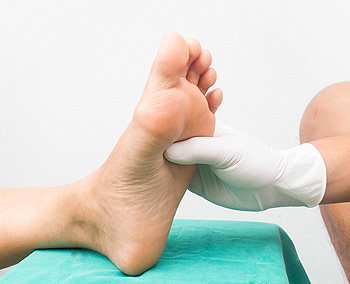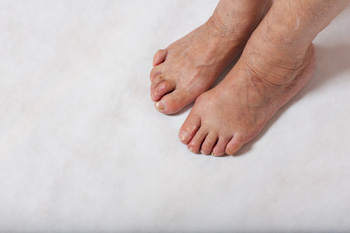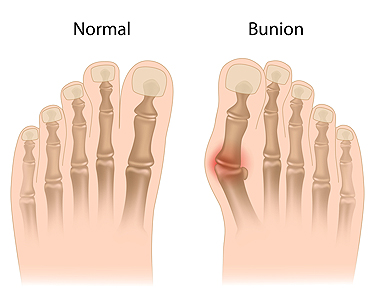July 2022
Checklist for Diabetics to Protect the Feet

Anyone with diabetes is subject to foot and lower leg problems, including ulcers, gangrene, and possible amputation. These conditions may be the result of long-term high blood sugar levels, which can cause neuropathy and peripheral artery problems. For that reason, as a diabetic, constant and vigilant care of your feet is essential. If you are unable to check your feet, please ask someone to help you. Some people use a mirror to check the bottom of their feet. Look for changes in skin color; red indicates a problem with your footwear, but blue or black could mean bruising or blood flow problems. Look for blisters or any break in the skin that could become infected. Keep these areas clean and dry, and apply sterile coverings. Check for moisture between the toes, which is a good place for bacterial or fungal infections, such as athlete’s foot, to develop. Notice any numbness, tingling, or inability to detect temperature, hot or cold. Look for sores that do not heal properly, because they may become ulcerated. As a diabetic, it is a good idea to have regularly scheduled visits with a podiatrist who can help to monitor changes to your feet and treat them quickly.
Diabetic foot care is important in preventing foot ailments such as ulcers. If you are suffering from diabetes or have any other concerns about your feet, contact one of our podiatrists from Coastal Foot & Ankle Wellness Center, LLC. Our doctors can provide the care you need to keep you pain-free and on your feet.
Diabetic Foot Care
Diabetes affects millions of people every year. The condition can damage blood vessels in many parts of the body, especially the feet. Because of this, taking care of your feet is essential if you have diabetes, and having a podiatrist help monitor your foot health is highly recommended.
The Importance of Caring for Your Feet
- Routinely inspect your feet for bruises or sores.
- Wear socks that fit your feet comfortably.
- Wear comfortable shoes that provide adequate support.
Patients with diabetes should have their doctor monitor their blood levels, as blood sugar levels play such a huge role in diabetic care. Monitoring these levels on a regular basis is highly advised.
It is always best to inform your healthcare professional of any concerns you may have regarding your feet, especially for diabetic patients. Early treatment and routine foot examinations are keys to maintaining proper health, especially because severe complications can arise if proper treatment is not applied.
If you have any questions please feel free to contact one of our offices located in St. Augustine, and Palatka, FL . We offer the newest diagnostic and treatment technologies for all your foot and ankle needs.
Walking Indoors Can Strengthen Toes

When babies are born, their feet are generally soft. Proper foot development is essential in developing gross motor skills, such as walking, standing, running, and jumping. The bones typically strengthen under stress, and this is crucial for performing these motor skills. Each foot is made up of 26 bones, which amount to one quarter of the bones in the body. They will continue to develop and strengthen until approximately 18 years of age. Research has shown the feet will grow to half of their adult size in their first year of life, and the flat feet that most babies are born with will gradually develop into a full arch in their teenage years. The toes will develop strength when the toddler can walk barefoot while indoors as often as possible. When it is time to purchase the first pair of shoes for walking outside, it is beneficial that the shoe is made of flexible materials and has a sturdy sole. If you would like additional information about how your child’s feet will develop, please schedule a consultation with a podiatrist who can answer any questions you may have.
Making sure that your children maintain good foot health is very important as they grow. If you have any questions, contact one of our podiatrists of Coastal Foot & Ankle Wellness Center, LLC. Our doctors can provide the care you need to keep you pain-free and on your feet.
Keeping Children's Feet Healthy
Having healthy feet during childhood can help prevent medical problems later in life, namely in the back and legs. As children grow, their feet require different types of care. Here are some things to consider...
Although babies do not walk yet, it is still very important to take care of their feet.
Avoid putting tight shoes or socks on his or her feet.
Allow the baby to stretch and kick his or her feet to feel comfortable.
As a toddler, kids are now on the move and begin to develop differently. At this age, toddlers are getting a feel for walking, so don’t be alarmed if your toddler is unsteady or ‘walks funny’.
As your child gets older, it is important to teach them how to take care of their feet.
Show them proper hygiene to prevent infections such as fungus.
Be watchful for any pain or injury.
Have all injuries checked by a doctor as soon as possible.
Comfortable, protective shoes should always be worn, especially at play.
If you have any questions please feel free to contact one of our offices located in St. Augustine, and Palatka, FL . We offer the newest diagnostic and treatment technologies for all your foot and ankle needs.
How Footwear Affects Hammertoe

To maintain healthy, strong feet, it is imperative to be familiar with common foot conditions, their causes, and how to prevent them. One troubling foot affliction that could threaten the vitality of your feet is called hammertoe, which has a notable causal relationship with certain kinds of footwear. Hammertoe affects the second, third, or fourth toe, occurring when an imbalance in the muscles around the toe’s middle joint causes the toe to stick up at the affected joint. This causes the toe to resemble a hammer. The condition, if left untreated, can make it especially difficult or painful to walk. Importantly, your choice of footwear can impact your likelihood of developing hammertoe. For example, shoes with small toe boxes that leave little room for the toes to sit comfortably in the shoe can force the toes into tight, twisted contortions. These contortions tighten the muscles in your toes, making hammertoe more likely. Additionally, high-heeled shoes can force your toes into tight, uncomfortable positions that might also tighten your muscles in the toes. To decrease your chances of developing a hammertoe, you might choose lower-heeled shoes with spacious toe boxes. If you think you have hammertoe or want to learn more about ways to prevent this condition, reach out to a podiatrist.
Hammertoe
Hammertoes can be a painful condition to live with. For more information, contact one of our podiatrists from Coastal Foot & Ankle Wellness Center, LLC. Our doctors will answer any of your foot- and ankle-related questions.
Hammertoe is a foot deformity that affects the joints of the second, third, fourth, or fifth toes of your feet. It is a painful foot condition in which these toes curl and arch up, which can often lead to pain when wearing footwear.
Symptoms
- Pain in the affected toes
- Development of corns or calluses due to friction
- Inflammation
- Redness
- Contracture of the toes
Causes
Genetics – People who are genetically predisposed to hammertoe are often more susceptible
Arthritis – Because arthritis affects the joints in your toes, further deformities stemming from arthritis can occur
Trauma – Direct trauma to the toes could potentially lead to hammertoe
Ill-fitting shoes – Undue pressure on the front of the toes from ill-fitting shoes can potentially lead to the development of hammertoe
Treatment
Orthotics – Custom made inserts can be used to help relieve pressure placed on the toes and therefore relieve some of the pain associated with it
Medications – Oral medications such as anti-inflammatories or NSAIDs could be used to treat the pain and inflammation hammertoes causes. Injections of corticosteroids are also sometimes used
Surgery – In more severe cases where the hammertoes have become more rigid, foot surgery is a potential option
If you have any questions please contact one of our offices located in St. Augustine, and Palatka, FL . We offer the newest diagnostic and treatment technologies for all your foot and ankle needs.
Do Your Child's Feet Hurt?
How Runners Can Address Troublesome Bunions
 Running is one of the most popular and widespread forms of exercise. Yet, bunions can often make this activity challenging or even painful. There are a variety of ways that individuals can manage the effects of bunions and continue to run. Bunions are bumps that occur usually on the base of the big toe when the metatarsophalangeal joint is stressed and strained. In some cases, bunions may form at the base of the pinky toe as well. If a runner has developed a bunion that is not causing serious pain, the runner may be able to continue running with wider footwear. Opting for wider running shoes can decrease the extent to which the bunion rubs up against the shoe and further aggravates or inflames the bump. Another way that runners may cope with bunions is by applying ice to the affected area for a short duration of time following the run. Toe spacers and bunion pads may also prove to be useful for runners looking to manage the annoyance of bunions. Bunions are certainly not ideal for runners, but a podiatrist may be able to help you address the affliction and get back on the running trail comfortably again.
Running is one of the most popular and widespread forms of exercise. Yet, bunions can often make this activity challenging or even painful. There are a variety of ways that individuals can manage the effects of bunions and continue to run. Bunions are bumps that occur usually on the base of the big toe when the metatarsophalangeal joint is stressed and strained. In some cases, bunions may form at the base of the pinky toe as well. If a runner has developed a bunion that is not causing serious pain, the runner may be able to continue running with wider footwear. Opting for wider running shoes can decrease the extent to which the bunion rubs up against the shoe and further aggravates or inflames the bump. Another way that runners may cope with bunions is by applying ice to the affected area for a short duration of time following the run. Toe spacers and bunion pads may also prove to be useful for runners looking to manage the annoyance of bunions. Bunions are certainly not ideal for runners, but a podiatrist may be able to help you address the affliction and get back on the running trail comfortably again.
If you are suffering from bunions, contact one of our podiatrists of Coastal Foot & Ankle Wellness Center, LLC. Our doctors can provide the care you need to keep you pain-free and on your feet.
What Is a Bunion?
A bunion is formed of swollen tissue or an enlargement of boney growth, usually located at the base joint of the toe that connects to the foot. The swelling occurs due to the bones in the big toe shifting inward, which impacts the other toes of the foot. This causes the area around the base of the big toe to become inflamed and painful.
Why Do Bunions Form?
Genetics – Susceptibility to bunions are often hereditary
Stress on the feet – Poorly fitted and uncomfortable footwear that places stress on feet, such as heels, can worsen existing bunions
How Are Bunions Diagnosed?
Doctors often perform two tests – blood tests and x-rays – when trying to diagnose bunions, especially in the early stages of development. Blood tests help determine if the foot pain is being caused by something else, such as arthritis, while x-rays provide a clear picture of your bone structure to your doctor.
How Are Bunions Treated?
- Refrain from wearing heels or similar shoes that cause discomfort
- Select wider shoes that can provide more comfort and reduce pain
- Anti-inflammatory and pain management drugs
- Orthotics or foot inserts
- Surgery
If you have any questions, please feel free to contact one of our offices located in St. Augustine, and Palatka, FL . We offer the newest diagnostic and treatment technologies for all your foot care needs.








